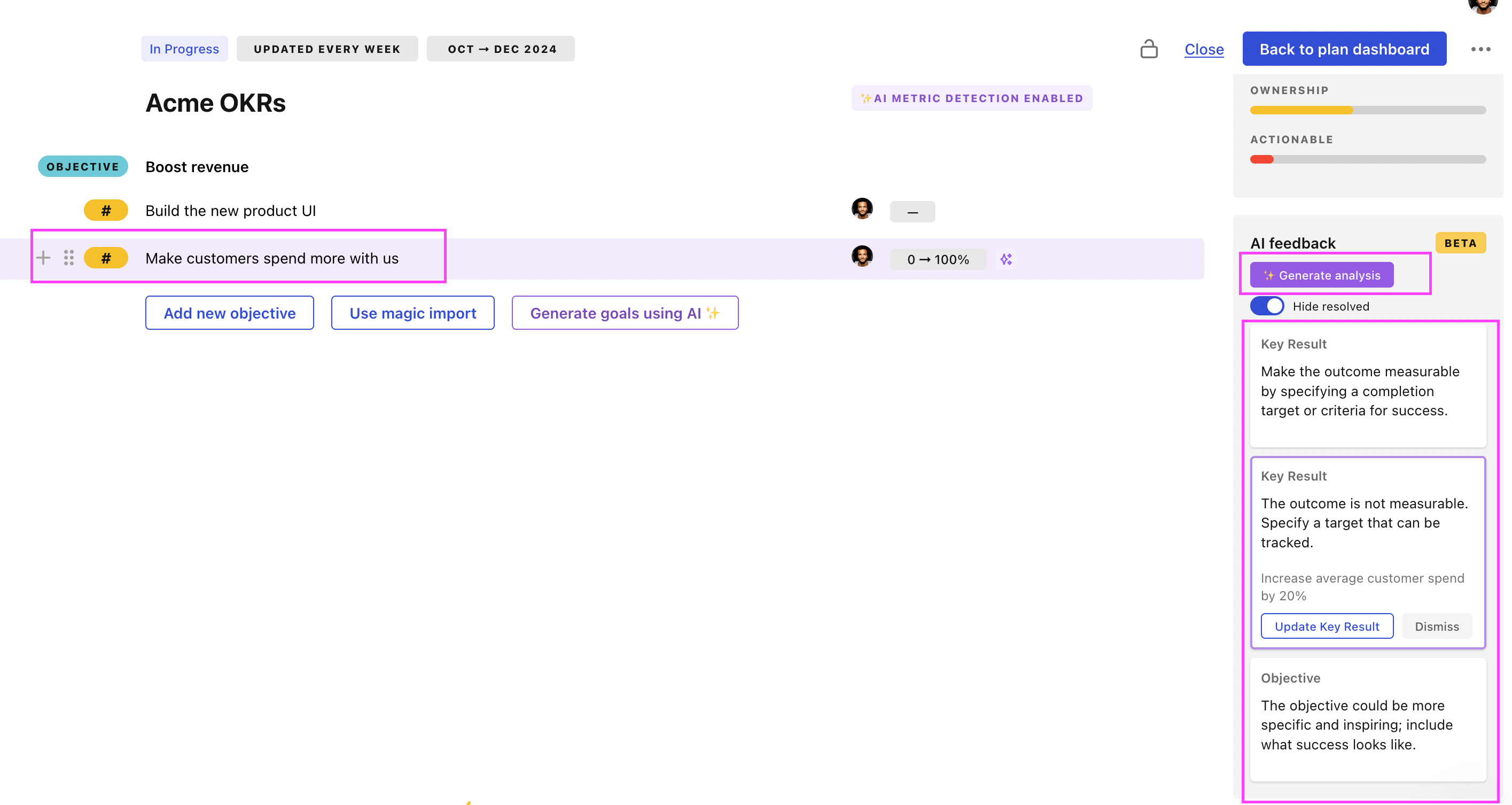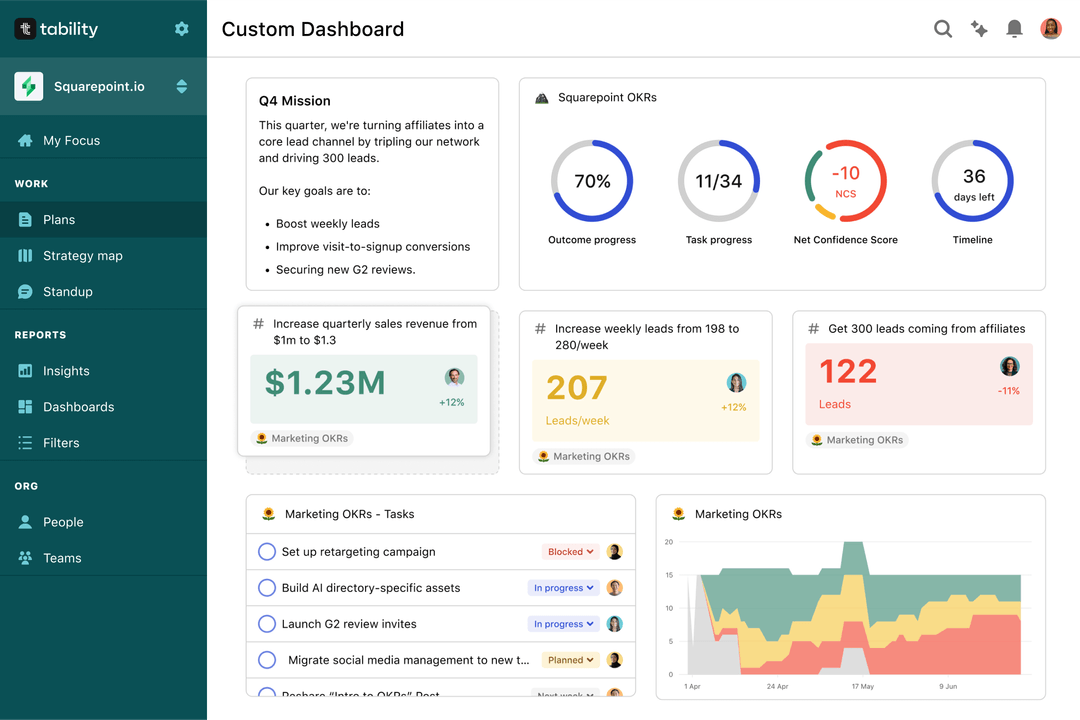Tability is a cheatcode for goal-driven teams. Set perfect OKRs with AI, stay focused on the work that matters.
What are Sustainable Energy OKRs?
The Objective and Key Results (OKR) framework is a simple goal-setting methodology that was introduced at Intel by Andy Grove in the 70s. It became popular after John Doerr introduced it to Google in the 90s, and it's now used by teams of all sizes to set and track ambitious goals at scale.
Creating impactful OKRs can be a daunting task, especially for newcomers. Shifting your focus from projects to outcomes is key to successful planning.
We have curated a selection of OKR examples specifically for Sustainable Energy to assist you. Feel free to explore the templates below for inspiration in setting your own goals.
If you want to learn more about the framework, you can read our OKR guide online.
The best tools for writing perfect Sustainable Energy OKRs
Here are 2 tools that can help you draft your OKRs in no time.
Tability AI: to generate OKRs based on a prompt
Tability AI allows you to describe your goals in a prompt, and generate a fully editable OKR template in seconds.
- 1. Create a Tability account
- 2. Click on the Generate goals using AI
- 3. Describe your goals in a prompt
- 4. Get your fully editable OKR template
- 5. Publish to start tracking progress and get automated OKR dashboards
Watch the video below to see it in action 👇
Tability Feedback: to improve existing OKRs
You can use Tability's AI feedback to improve your OKRs if you already have existing goals.
- 1. Create your Tability account
- 2. Add your existing OKRs (you can import them from a spreadsheet)
- 3. Click on Generate analysis
- 4. Review the suggestions and decide to accept or dismiss them
- 5. Publish to start tracking progress and get automated OKR dashboards

Tability will scan your OKRs and offer different suggestions to improve them. This can range from a small rewrite of a statement to make it clearer to a complete rewrite of the entire OKR.
Sustainable Energy OKRs examples
You will find in the next section many different Sustainable Energy Objectives and Key Results. We've included strategic initiatives in our templates to give you a better idea of the different between the key results (how we measure progress), and the initiatives (what we do to achieve the results).
Hope you'll find this helpful!
OKRs to boost sustainable energy for optimal CRM machine operation
ObjectiveBoost sustainable energy for optimal CRM machine operation
KRReduce CRM machine downtime by 15%
Implement routine preventative maintenance protocols
Upgrade outdated components regularly
Train operators on correct CRM machine usage
KRIncrease CRM machine energy efficiency by 20%
KRImplement renewable energy sources for 50% of CRM machine power needs
Review current energy consumption of CRM machines
Develop implementation plan for new energy sources
Research suitable renewable energy sources
OKRs to boost operational capacity of ATMs via sustainable energy solutions
ObjectiveBoost operational capacity of ATMs via sustainable energy solutions
KRSecure partnerships with 3 renewable energy providers by the quarter's end
Set up meetings to discuss partnership opportunities
Finalize agreements with selected providers
Identify potential renewable energy providers for partnership
KRAchieve a 10% reduction in power-related ATM downtime
Implement a power backup/UPS system for all ATMs
Upgrade outdated ATM hardware to increase energy efficiency
Perform regular preventive maintenance on all ATMs
KRRetrofit 30% of existing ATMs to run on sustainable power sources
Implement retrofit strategy for chosen ATMs
Identify ATMs optimal for sustainable power conversion
Find suppliers providing eco-friendly power solutions
OKRs to boost sustainable power for CRM machine uptime
ObjectiveBoost sustainable power for CRM machine uptime
KRAchieve 10% reduction in CRM machine power-related outages by week 9
KREvaluate CRM machine's current power usage by end of week 2
Gather all recent power consumption data for the CRM machine
Review and analyze the collected data thoroughly
Draft a report based on the analysis by end of week 2
KRImplement at least 2 energy efficient upgrades by week 6
Implement chosen energy-efficient upgrades by week 6
Identify potential areas for energy-efficient upgrades
Research and select two effective upgrade options
OKRs to enhance ATM availability through sustainable power
ObjectiveEnhance ATM availability through sustainable power
KRAchieve a reduction of power-related ATM downtime by 25%
KRSuccessfully install green power source to 100% of targeted ATMs
Purchase and install appropriate green power sources
Conduct tests to ensure successful installation
Evaluate required energy levels for each target ATM
KRResearch and select the most efficient, green power source by evaluating 5 alternatives
Identify and list down five green power alternatives
Research thoroughly on each power alternative
Choose the most efficient green power source
Sustainable Energy OKR best practices
Generally speaking, your objectives should be ambitious yet achievable, and your key results should be measurable and time-bound (using the SMART framework can be helpful). It is also recommended to list strategic initiatives under your key results, as it'll help you avoid the common mistake of listing projects in your KRs.
Here are a couple of best practices extracted from our OKR implementation guide 👇
Tip #1: Limit the number of key results
The #1 role of OKRs is to help you and your team focus on what really matters. Business-as-usual activities will still be happening, but you do not need to track your entire roadmap in the OKRs.
We recommend having 3-4 objectives, and 3-4 key results per objective. A platform like Tability can run audits on your data to help you identify the plans that have too many goals.
Tip #2: Commit to weekly OKR check-ins
Don't fall into the set-and-forget trap. It is important to adopt a weekly check-in process to get the full value of your OKRs and make your strategy agile – otherwise this is nothing more than a reporting exercise.
Being able to see trends for your key results will also keep yourself honest.
Tip #3: No more than 2 yellow statuses in a row
Yes, this is another tip for goal-tracking instead of goal-setting (but you'll get plenty of OKR examples above). But, once you have your goals defined, it will be your ability to keep the right sense of urgency that will make the difference.
As a rule of thumb, it's best to avoid having more than 2 yellow/at risk statuses in a row.
Make a call on the 3rd update. You should be either back on track, or off track. This sounds harsh but it's the best way to signal risks early enough to fix things.
Save hours with automated Sustainable Energy OKR dashboards

Your quarterly OKRs should be tracked weekly if you want to get all the benefits of the OKRs framework. Reviewing progress periodically has several advantages:
- It brings the goals back to the top of the mind
- It will highlight poorly set OKRs
- It will surface execution risks
- It improves transparency and accountability
Spreadsheets are enough to get started. Then, once you need to scale you can use Tability to save time with automated OKR dashboards, data connectors, and actionable insights.
How to get Tability dashboards:
- 1. Create a Tability account
- 2. Use the importers to add your OKRs (works with any spreadsheet or doc)
- 3. Publish your OKR plan
That's it! Tability will instantly get access to 10+ dashboards to monitor progress, visualise trends, and identify risks early.
More Sustainable Energy OKR templates
We have more templates to help you draft your team goals and OKRs.
OKRs to optimize resource allocation and budget management
OKRs to broaden understanding of royalty components in contracts
OKRs to implement effective OKR framework for document management
OKRs to enhance customer experience through improved operations and quality solutions
OKRs to enhance my teaching effectiveness and student engagement
OKRs to elevate proficiency and scores in Mathematics